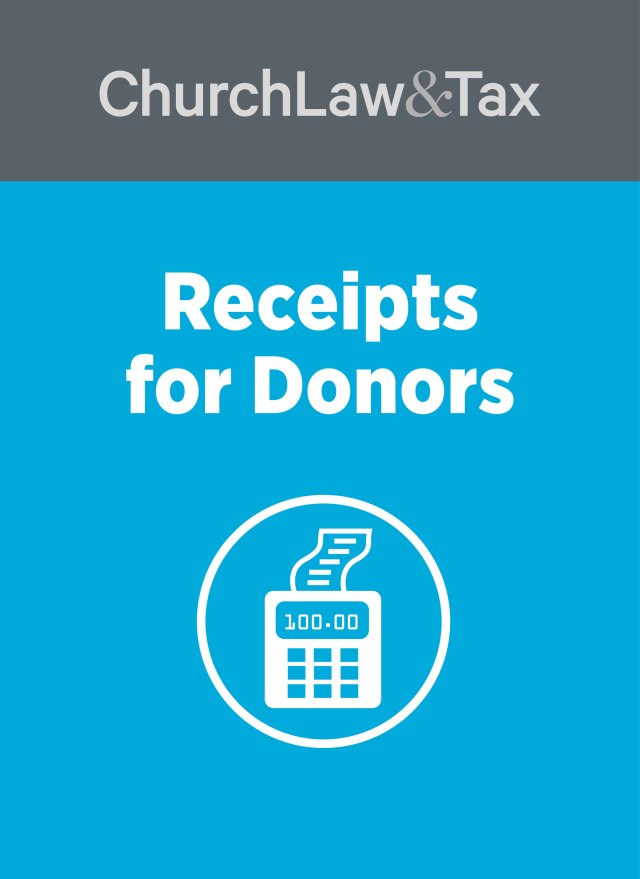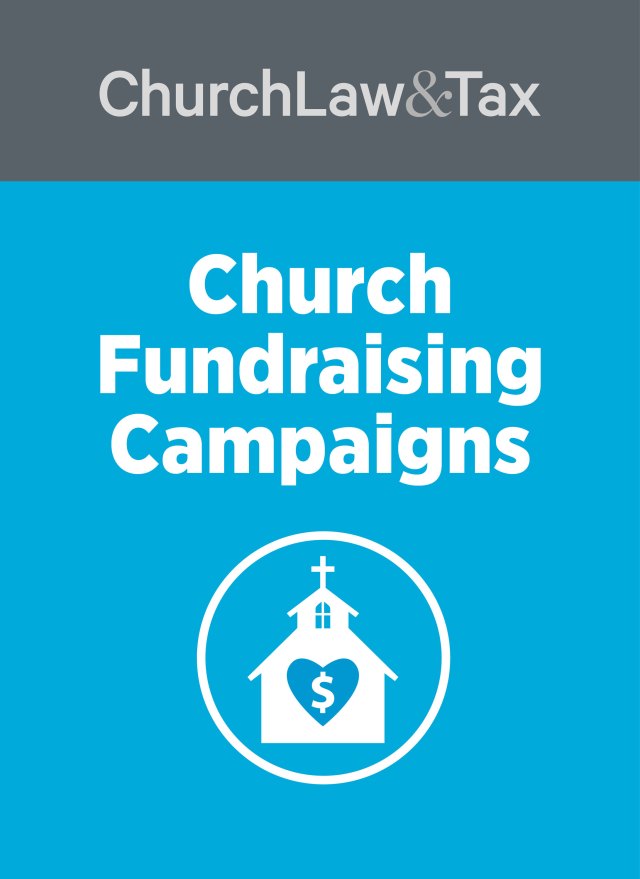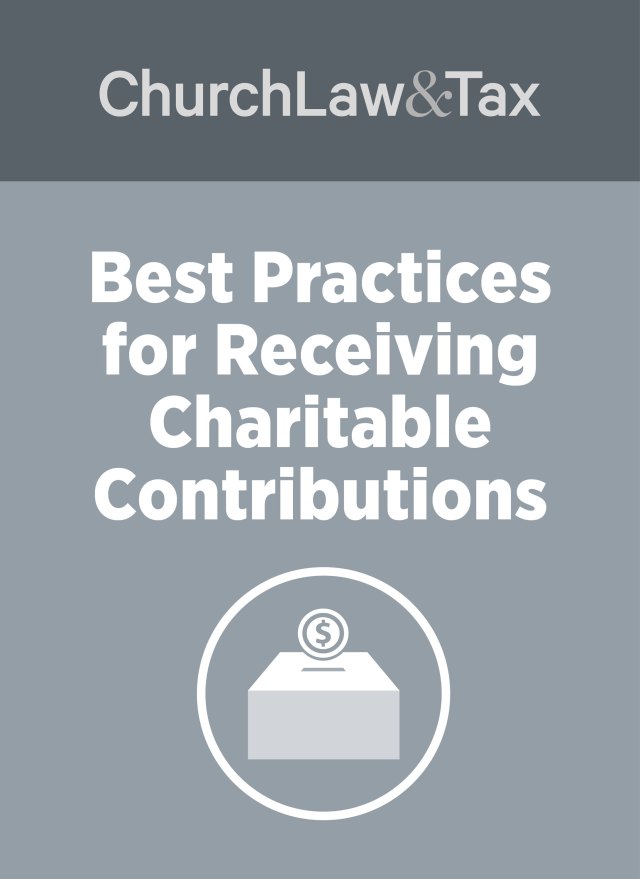In August Congress enacted the massive Pension Protection Act of 2006. While primarily a pension reform law, the Act contains a number of provisions pertaining to public charities and charitable contributions. Most notably, the Act imposes new requirements on the substantiation of charitable contributions. These requirements take effect immediately, and must be understood by church treasurers in order to ensure that donors will be able to deduct their cash contributions.
This article will address 10 provisions in the new law of special relevance to church treasurers.
1. Tax-free distributions from IRAs for charitable purposes
IRA owners who are least 70 1/2 years of age can make tax-free distributions of up to $100,000 from a traditional IRA or a Roth IRA to a tax-exempt church or charity. This provision is effective through 2007.
2. Charitable deduction for contributions of food inventory
Any taxpayer engaged in a trade or business is eligible to claim an enhanced deduction for donations of food inventory. The total deduction for donations of food inventory in a given year generally may not exceed 10 percent of the taxpayer’s net income for the year from all business entities from which contributions of “apparently wholesome food” are made. This provision is effective for contributions made in 2006 and 2007.
3. Modification of recordkeeping requirements for cash contributions
Caution. The Pension Protection Act of 2006 changes the way that donors substantiate cash contributions to a church or charity. Church treasurers must be familiar with these new rules to ensure that members will be able to deduct their cash contributions. The new rules took effect upon enactment of the Act on August 17, 2006.
The Act made an important change in the way that contributions of cash are substantiated. It amended the tax code to require all cash contributions, regardless of amount, to be substantiated by either a bank record (such as a cancelled check) or a written communication from the donee charity showing the name of the charity, the date of the contribution, and the amount of the contribution.
The recordkeeping requirements may not be satisfied by maintaining “other written records.” In the past, donors could substantiate cash contributions of less than $250 with “other reliable written records showing the name of the donee, the date of the contribution, and the amount of the contribution” if no cancelled check or receipt was available. This is no longer allowed. This change is effective immediately.
Example. A church member makes cash contributions to his church of between $20 and $50 each week. He uses offering envelopes provided by the church, but the church provides no other receipt or statement substantiating the contributions. The member will not be able to claim a charitable contribution deduction for any of these payments (made after August 17, 2006). The Pension Protection Act of 2006 amended the tax code to require all cash contributions, regardless of amount, to be substantiated by either a bank record (such as a cancelled check) or a written communication from the donee showing the name of the donee organization, the date of the contribution, and the amount of the contribution. The recordkeeping requirements may not be satisfied by maintaining other written records.
Example. A member makes a contribution (by check) of $1,000 to her church’s building fund in December of 2006. The Pension Protection Act of 2006 amended the tax code to require all cash contributions, regardless of amount, to be substantiated by either a bank record (such as a cancelled check) or a written communication from the donee showing the name of the donee organization, the date of the contribution, and the amount of the contribution. The recordkeeping requirements may not be satisfied by maintaining other written records. For many years the tax code also has disallowed a charitable contribution deduction for any contribution of $250 or more unless the taxpayer substantiates the contribution by a contemporaneous written acknowledgement of the contribution from the donee charity. The acknowledgement must include the amount of cash, whether the donee provided any goods or services in consideration for the contribution, and a good faith estimate of the value of any such goods or services. This requirement was not affected by the Pension Protection Act of 2006. Rather, it is in addition to the new rules.
4. Reduction in charitable contribution deduction for appreciated tangible personal property not used for charitable purposes
“Tangible personal property” is any property, other than land or buildings, that can be seen or touched. It includes such items as furniture, antiques, books, jewelry, stamp or coin collections, equipment, computers, vehicles, clothing, and works of art. In most cases such property declines in value over time, meaning that its market value is less than what the owner paid for it (the property’s “cost basis”). Donors who contribute such property to a church or charity generally may claim a charitable contribution deduction in the amount of the property’s cost basis.
But some tangible personal property increases in value over time. Generally, the amount of a charitable contribution deduction in such a case is the donated property’s fair market value at the time of the contribution, and not the cost basis. In other words, the donor gets to deduct not just the cost basis of the donated property, but also the amount the property has increased in value. There is an important exception to this rule. The amount of a charitable contribution deduction for a donation of appreciated tangible personal property that is not used by the church or charity for its tax-exempt purposes must be reduced from market value to cost basis. This means that the donor is not able to deduct the gain or appreciation in the donated property.
The Pension Protection Act of 2006 amends the tax code to reduce a donor’s contribution deduction for a donation of appreciated tangible personal property to the property’s cost basis if the charity does not use the property for exempt purposes for a minimum of three years. This rule only applies to donated property that is identified by the charity (for example on Form 8283) as having a use related to the charity’s tax-exempt purposes, and for which a deduction of more than $5,000 is claimed.
If a charity disposes of the property in the tax year the contribution is made, the donor’s deduction generally is his or her cost basis rather than the donated property’s fair market value. If the disposition occurs in a subsequent year (but during the three-year period following the contribution) the donor must include as ordinary income for the taxable year in which the disposition occurs an amount equal to the excess (if any) of (i) the amount of the deduction previously claimed by the donor as a charitable contribution with respect to the property, over (ii) the donor’s cost basis in the property at the time of the contribution.
Key point. There is no reduction in the charitable contribution deduction if the charity makes a certification to the IRS by written statement signed under penalties of perjury by an officer of the charity. The statement must either (1) certify that the use of the property by the charity was related to the purpose or function constituting the basis for its exemption, and describe how the property was used and how such use furthered such purpose or function; or (2) state the intended use of the property by the charity at the time of the contribution and certify that such use became impossible or infeasible to implement. The charity must furnish a copy of the certification to the donor (for example, as an attachment to Form 8282, a copy of which is supplied to the donor).
Key point. A penalty of $10,000 applies to a person who identifies property as having a use related to a purpose or function constituting the basis for the charity’s tax exemption knowing that it is not intended for such a use.
5. Form 8282 reporting requirement
Generally, donors must obtain a qualified appraisal for a donation of property (other than money or certain publicly traded securities) for which a charitable contribution deduction in excess of $5,000 is claimed. The donor must also complete a summary of the qualified appraisal (on Form 8283, Section B), and attach it to the income tax return on which the contribution deduction is claimed. This summary must be signed by the donee charity. In the past, if the charity disposed of donated property for which it signed a qualified appraisal summary, and the disposal (by sale or otherwise) occurred within two years of the date of the contribution, it was required to file a “donee information return” (Form 8282) with the IRS.
The Act modifies the Form 8282 reporting requirement in the following three ways:
- The Form 8282 reporting requirement is extended to dispositions of donated property within three years after the date of the contribution (up from two years under prior law).
- Form 8282 must include, in addition to the information already required on the return, a description of the donee charity’s use of the property, a statement of whether use of the property was related to the purpose or function constituting the basis for the donee’s exemption, and, if applicable, a certification of any such use.
- The charitable contribution deduction available to donors who contribute appreciated tangible personal property to a charity is not reduced (from market value to cost basis) if the donee charity makes a certification to the IRS by written statement signed under penalties of perjury by an officer of the charity that either (1) certifies that the use of the property by the charity was related to the purpose or function constituting the basis for its exemption, and describe how the property was used and how such use furthered such purpose or function; or (2) states the intended use of the property by the charity at the time of the contribution and certifies that such use became impossible or infeasible to implement. The charity must furnish a copy of the certification to the donor (for example, as an attachment to Form 8282, a copy of which is supplied to the donor).
This provision is effective for contributions made and returns filed after September 1, 2006, and with respect to the penalty, for identifications made after the date of enactment.
Example. A church member purchased a coin collection in 1990 for $3,000 that is worth $10,000 today. He donates the collection to his church in December of 2006. The church sells the collection shortly after the contribution, and never used it for a “related purpose.” Since the church did not use the donated property in furtherance of its exempt purposes, the member’s charitable contribution deduction is limited to the property’s cost basis ($3,000) rather than its market value ($10,000). Since the contribution deduction does not exceed $5,000, the donor is not required to obtain a qualified appraisal or complete a qualified appraisal summary (Form 8283, Section B), and the church is not required to file Form 8282 with the IRS upon its sale of the collection.
6. Fines and penalties applicable to charitable organizations
Under prior law, the IRS could assess a penalty against “managers” of a church or other charity who approved an “excess benefit transaction” unless a manager could demonstrate that his or her approval was “not willful and due to reasonable cause.” This penalty was in the form of an excise tax of up to 10% of the amount of the excess benefit, with a maximum of $10,000 per manager (but the total tax on all directors could not exceed $10,000).
The Pension Protection Act of 2006 increases the 10% amount to 20%. It also doubles the dollar limitation on managers for participation in excess benefit transactions from $10,000 per transaction to $20,000 per transaction.
Example. In 2007 a church sends its pastor and his wife on an all-expense-paid trip to Hawaii in honor of their 25th wedding anniversary. The total cost of the trip is $8,000. The church treasurer assumes that this amount is a nontaxable fringe benefit, and so she does not report any of the $8,000 on the pastor’s W-2. The pastor likewise assumes that the cost of the trip is a nontaxable benefit. The church’s payment of these travel expenses constitutes an automatic excess benefit resulting in intermediate sanctions since it was not reported as taxable income by either the church or pastor in the year the benefit was provided. This is so even though the amount of the benefit by itself, or when added to the pastor’s other church compensation, is reasonable in amount, This may result in (1) the assessment of penalties against the pastor, and (2) an excise tax of up to 20% of the amount of the excess benefit against each member of the church board who approved the transaction, up to a maximum of $20,000. While each board member is individually liable for the full 20% penalty, the IRS can only collect the penalty once. This means that if the IRS collects the penalty ($1,600) against one director, it cannot assess additional penalties against any other director.
7. Clothing and household items
The Pension Protection Act of 2006 amends the tax code to deny a charitable contribution deduction for a contribution of clothing or household items unless the clothing or household items are in “good used condition or better.” The Treasury Department is authorized to deny (by regulation) a deduction for any contribution of clothing or a household item that has minimal monetary value, such as used socks and used undergarments.
Under the new provision, a deduction may be allowed for a charitable contribution of an item of clothing or a household item not in good used condition or better only if the amount claimed for the item is more than $500 and the taxpayer includes with his or her tax return a qualified appraisal with respect to the property. Household items include furniture, furnishings, electronics, appliances, linens, and other similar items. Food, paintings, antiques, and other objects of art, jewelry and gems, and collections are excluded from this provision.
8. Appraisal reform
Taxpayers are required to obtain a qualified appraisal for donated property with a value of more than $5,000, and to attach an appraisal summary to their tax return (Form 8283, Part B). The Pension Protection Act of 2006 makes the following changes in the qualified appraisal requirement:
- Qualified appraiser. It amends the tax code to define a qualified appraiser as an individual who (1) has earned an appraisal designation from a recognized professional appraiser organization or has otherwise met minimum education and experience requirements to be determined by the IRS in regulations; (2) regularly performs appraisals for which he or she receives compensation; (3) can demonstrate verifiable education and experience in valuing the type of property for which the appraisal is being performed; (4) has not been prohibited from practicing before the IRS by the Secretary at any time during the three years preceding the conduct of the appraisal; and (5) is not excluded from being a qualified appraiser under applicable Treasury regulations.
- Qualified appraisal. It amends the tax code to define a qualified appraisal as an appraisal of property prepared by a qualified appraiser (as defined by the provision) in accordance with generally accepted appraisal standards and any regulations or other guidance prescribed by the IRS.
- Civil penalty. It amends the tax code to create a civil penalty that the IRS can assess against any person who prepares an appraisal that is to be used to support a tax position if the appraisal results in a substantial or gross valuation misstatement. The penalty is equal to the greater of $1,000 or 10 percent of the understatement of tax resulting from a substantial or gross valuation misstatement, up to a maximum of 125 percent of the gross income derived from the appraisal. The penalty does not apply if the appraiser establishes that it was “more likely than not” that the appraisal was correct.
9. Public disclosure of information relating to unrelated business income tax returns
The Pension Protection Act of 2006 amends the tax code to make the annual unrelated business income tax return (Form 990-T) subject to public inspection. The new law specifies that certain information may be withheld by the organization from public disclosure and inspection if public availability would “adversely affect” the organization.
Example. A church operates a bookstore on its premises that is open to the general public. Net earnings from the bookstore are $15,000 in 2007. The church pays the unrelated business income tax on this income, using Form 990-T. This form is now subject to public inspection. This means that the church must make the form available for inspection during regular business hours to any person who asks to see it, without charge other than a reasonable fee for any reproduction or mailing costs. The request to inspect may be made in person or in writing. If made in person, the copy must be provided immediately and, if made in writing, it must be provided within 30 days.
10. Elimination of “sunset” retirement provisions
The Economic Growth and Tax Relief Reconciliation Act of 2001 (EGTRRA) made a number of changes to the tax code pertaining to pension plans and IRAs. However, EGTRRA included a “sunset” provision under which all of these provisions expired at the end of 2010. The Pension Protection Act of 2006 makes these provisions permanent. These include increased IRA contribution and 403(b) contribution limits (including catch-up limits for persons who are at least 50 years of age).
This article first appeared in Church Treasurer Alert, October 2006.




